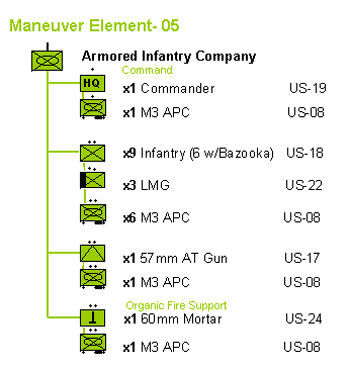
Smaller explosives supplemented them (grenades, explosive charges, smoke charges and in the case of sappers, mines).The US Armys World War II infantry division was built around three infantry regiments. Combat experience in the First World War led to massive reorganizations, and by 1939, with the introduction of light yet powerful support weapons, the company had been transformed into a flexible and effective organization with several subunits under command.Pistols, rifles, carbines, submachine guns, machine guns, and AT rifles equipped engineer, reconnaissance and regular infantry units. Ever since the dawn of armored warfare after World War I, there has been a need for an antitank weapon to allow the infantry to fight toe-to-toe with.German and Soviet army staffs combined four main categories of tools to fashion their land armies:The Infantry Company was the basic unit of manoeuvre in an Infantry Battalion at the opening of the 20th Century. An Infantry division had 9 infantry battalions, in 3 brigades, see here for divisional TO&E. The same organisation was used for the infantry battalions of the infantry brigades of both Infantry and Armoured divisions. WWII British Infantry Battalion TO&E (or TOE) Below is a 1:1 schematic image of a WWII British Infantry battalion TO&E (Table of Organisation and Equipment, TOE).

Based on a study of its performance in battle, the Germans modified the organization of the armored division frequently. A mass of tanks on the attack repeatedly defeated an outnumbered anti-tank defense returning the mobility to the battlefield. Even the lightest of German tanks incorporated 13mm of hardened, homogeneous armor which was impervious to armor-piercing bullets fired from rifle-caliber machine guns !.

Armored combat vehicles were inherently powerful but had crucial operational limitations. I and II decreased to 35% !.This qualitative increase conferred the 1941 panzer divisions much more striking power.To boost the effectiveness of the panzers, the Germans assigned fully motorized supporting elements that could keep pace with them. Kpfw 35(t) and 38(t) to 23%, while the light Pz. III and IV proportion increased to 42%, Pz. 35(t), 38(t) and command tanks.The tank modernization program could boast significant improvements by 22 June 1941. I and II accounted for 78% of the German tank park while the balance consisted of small numbers of Pz.
During an attack, their limited visibility prevented the swift identification of every enemy’s camouflaged positions. Three Engineer companies (1 armored and 2 motorized), one “K” bridge train and a motorized column carrying all supplies constituted the battalion.Tanks could capture ground, but they could not mop-up conquered territory or defend it against infiltration, especially at night. It also helped to destroy field fortifications that could not be neutralized by the tank’s guns. An armored engineer battalion was an integral part of the panzer division to remove barriers and to construct bridges and other suitable corridors thus restoring mobility.
These guns could deliver significant firepower on stubborn defenders, helping the panzers to overcome strong defensive positions.Forward observers in armored vehicles moved behind the first wave of tanks to spot targets and radioed their coordinates to the artillery commanders !. Thus, the German panzer division contained 2 motorized infantry regiments, each composed of 2 motorized infantry battalions, to support its single panzer regiment !.The Soviet and Anglo-American armies would later arrive at the same organization and even though they had at their disposal much more tanks than the Germans, they kept this infantry-to-tank ratio !.Divisional artillery support took the form of a motorized artillery regiment composed of two light field artillery battalions equipped with 105mm howitzers and one medium field artillery battalion furnished with 150mm howitzers. The Germans stumbled upon the optimal ratio of infantry to tanks at about this time: 2 infantry battalions per every tank battalion.
...
They were organized in such a way that the division could be broken up into two or more self-sufficient teams. I chassis.An organic mobile signals battalion with radio and telephone companies had the mission to construct the command, communication and control network that allowed the commanding officers to come up with a clear picture of the situation and to distribute appropriate orders.Finally, and of decisive importance, the divisional services contained fully motorized units that provided the combat troops with the necessary supplies to move, live and fight, adjusting their capacity to the changing conditions.


 0 kommentar(er)
0 kommentar(er)
